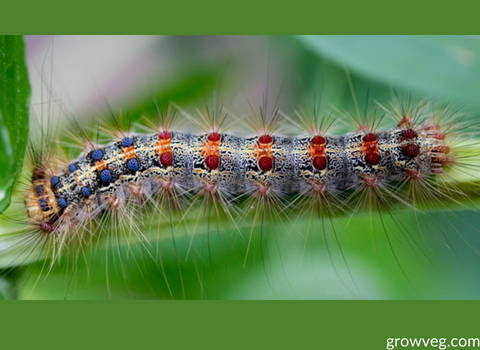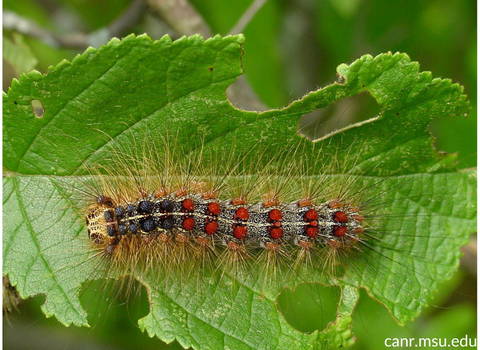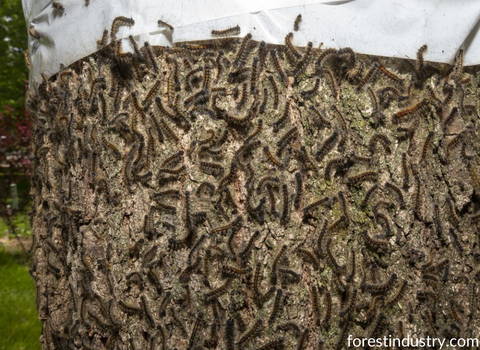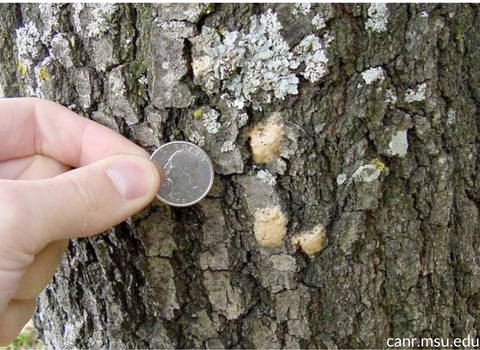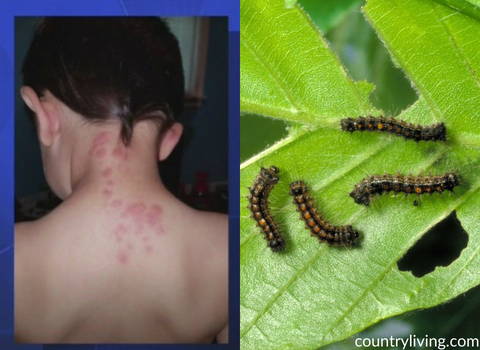Gypsy Moth Caterpillar: What They Look Like and How to Eliminate Them
The gypsy moth is an invasive species of moth that first appeared in the United States when French astronomer, amateur entomologist and artist Leopold Trouvelot imported some gypsy moth eggs to Medford, Massachusetts. Trouvelot wanted to breed silk-spinning caterpillars that were more resistant to diseases than the domesticated silkworms.
However, the caterpillars escaped and 10 years later, they started to appear in large numbers. By the late 1880s, the moths were causing extreme defoliation in the region. Populations and defoliation have also been found in Nova Scotia, British Columbia, New Brunswick, southern Ontario, and other parts of Ontario. Gypsy moth populations vary each year and fluctuate with local conditions.
Gypsy Moth Caterpillar Damage
The gypsy moth is also known as LDD moths (Lymantria dispar dispar). Another name for the gypsy moth is the North American gypsy moth or European gypsy moth. Regardless of its name, the fact remains that it feeds on various tree species found throughout North America and the Greater Toronto Area and causes defoliation.
When gypsy moth outbreaks occur and the moth populations are high, thousands of acres of forests and trees can be damaged. Gypsy moths do not pose any major threat to the forest and natural resources of New York, but they are not native. Moreover, their population can reach outbreak levels.
The gypsy moth eats young leaves during the spring. Defoliation reduces the resistance and vigour of deciduous trees, which are known for being able to withstand 2 to 3 consecutive years of defoliation. The trees also become more susceptible to diseases and pests.
Tree death occurs when other factors like insect outbreaks, harsh weather, and diseases attack trees within the same year. When other hosts are limited and the gypsy moth population is extremely high, they will consume evergreen species like hemlock and spruce. Evergreens do not regrow leaves easily. Thus, they can die due to complete defoliation.
Gypsy Moth Life Cycle
The gypsy moth goes through different life stages – eggs, larvae or caterpillars, pupa, and adult moths. The caterpillars hatch in May from egg masses deposited in sheltered places or tree trunks and they start feeding on the tree leaves.
Many of them spin long threads and drop down from the leaf using these threads. The wind helps disperse the caterpillars to other trees. Once they find the right tree, they start feeding on the leaves. Gypsy moths love hardwood trees like oak trees, apple trees and birch trees.
They grow fast and moult their skins to keep up with their growing size. After moulting a few times, they descend from the host tree before dawn to avoid light and spend the rest of the day in a dark, dry, and sheltered spot under loose tree bark, on the underside of objects and in leaf piles below trees. They climb back up at dusk by following their silk thread. It is usually at this point that people start to notice the defoliation of host trees and the caterpillars.
In July, the caterpillars pupate in a sheltered location like the underside of lawn furniture and tree limbs. After 2 weeks, the adult moths appear. The white-and-buff female moths are flightless and give off a sex pheromone. This pheromone attracts the smaller, brown-coloured male moths. They mate in July or August and the female moth deposits an egg mass on a tree trunk, branch, or other surfaces.
The egg mass contains up to 1000 eggs and yellowish hairs from the female’s abdomen. The moth dies after breeding. The eggs masses live through the winter and a new generation of gypsy moths is born in the spring.
Control Measures for Gypsy Moth Caterpillars
Some native birds like gray catbirds, common grackles, cuckoos, and downy woodpeckers prey on gypsy moth caterpillars. Gray squirrels and white-footed mice also eat gypsy moth pupae and larvae. Moreover, there are insect predators that target the pupae, eggs, and larvae of gypsy moths.
These insect predators work as natural biological controls on the gypsy moth population. One example of such a predator is the Calosoma sycophanta. The larva of this beetle eats the gypsy moth pupae and the adult preys on the larvae.
Eastern Tent Caterpillar
The eastern tent caterpillar and the gypsy moth caterpillar are frequently confused, but you can easily tell them apart by comparing their markings. You will find 5 pairs of blue dots and 6 rows of red warts on the back of a gypsy moth caterpillar.
The eastern tent caterpillar does not have warts. It has a yellowish-white center stripe and elaborate markings in white, blue, and orange. Eastern tent caterpillars hatch early and become noticeable by May. On the other hand, the gypsy moth larvae are only starting to come out by May. They are small and not noticeable at this point.
How to Find and Destroy Egg Masses
Destroying eggs of gypsy moths can help control the populations of these insects. It is also a great alternative to pesticide use. Eliminating egg masses can prevent the eggs from hatching. Thus, this method can lower the overall impact of gypsy moth defoliation on the trees on your property and other areas. So, what do egg masses look like? They are tan, fuzzy, and tiny. Egg masses are laid in large clumps or individually.
It is usually found in sheltered, flat locations like the crevices of landscaping rocks, fences and patio furniture and underside of branches and other shielded areas. You can destroy egg masses as soon as they are laid. Just wait until the tree leaves have fallen and do it when the weather is good so that you can get better visibility.
Once you have found the egg mass, you can start destroying them. First, place the catchment container underneath the egg mass. Next, use a scraper tool to get rid of the mass. Do not leave any residual egg in the crevices or bark rides. Empty the container’s contents into a pail of soapy water. Lastly, leave the egg mass soaking in soapy water for one or two days then throw away the contents.
For more information about the gypsy moth caterpillars, visit bugwood.org. Bugwood Center for Invasive Species and Ecosystem Health’s staff develops information technology and partnerships to improve invasive species management, forest health and integrated pest management.
If you have questions, you can search the site or contact the staff and ask them about the best options for eliminating gypsy moths on your property and other areas. The site also contains information about other destructive insects. Whether you are in Ontario or another location, you will find what you are looking for at bugwood.org.
You can also search the official website of the USDA Forest Service for gypsy moth caterpillar pictures and in-depth information regarding gypsy moth damage as well as pest populations and number in Ontario and other areas. Aside from this, you can search the page for the list and images of insects that can be found in Ontario or throughout the U.S. The site also contains the latest news and facts regarding these insects.
Products we recommend for controlling gypsy moth caterpillars are:
Gypsy Moth Caterpillar Rash
Some people develop rashes after coming into contact with a gypsy moth. Symptoms can include mild or moderate pain or sting accompanied by vesicles, welts, patches of inflamed, scaly skin and raised red bumps. If you have come into contact with moths, try to get rid of the hairs and use pain relievers to alleviate the pain. And if serious side effects begin to occur such as shortness of breath, visit your doctor immediately.


